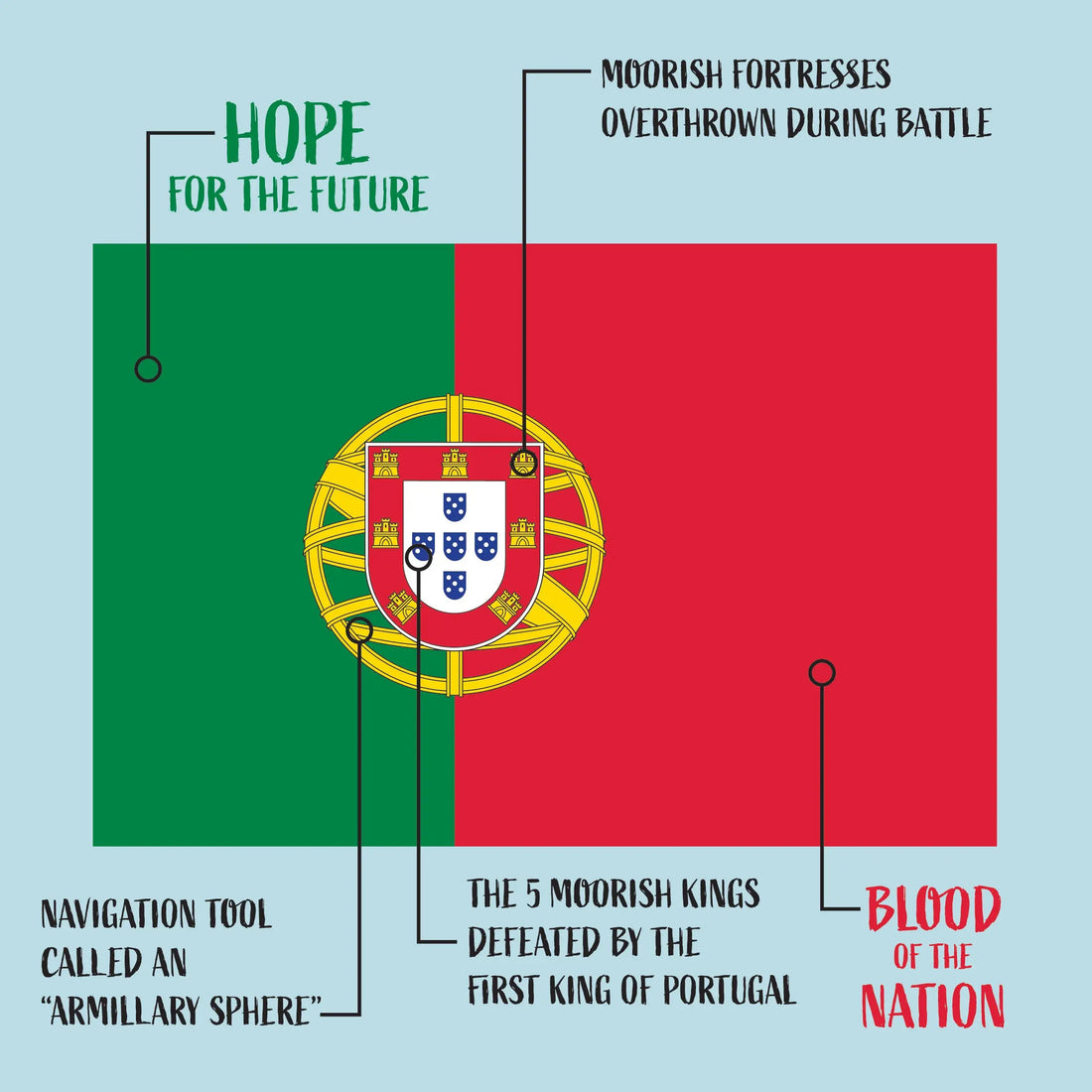
The current Portuguese flag is not only a beautiful work of art, it contains a masterful combination of symbolism that has been in existence since 1911. With this beauty comes symbolism that can be somewhat complicated to explain.
Known in Portugal as Bandiera the Quinas and Bandeira Verde-Rubra, it was proposed one year after the Portuguese monarchy was overthrown. Commissioned to design the Portuguese flag was a painter, a writer, and a journalist. Columbano Bordalo Pinheiro, who is usually referred to as Columbano, was a Portuguese Realist painter and considered the greatest Portuguese painter of the 19th century. João Pinheiro Chagas, a prolific journalist, spent most of his life rebelling against institutions resulting in many arrests not only in Portugal but also in Africa. While he wrote numerous short stories, novels, and plays, less is written about the third designer, Abel Botelhois. He was known to have a successful career in the Portuguese military and as a diplomat but those seem to be overshadowed by the products of his writing. It is widely believed that the newly formed Portuguese government commissioned the three men based on the men's political convictions which, in turn, influenced the design of the flag.
Despite knowing who designed the flag and the era in which it was designed, there’s more than one explanation for some of its elements. Below is the most popular explanation for each part of the current Portuguese flag.
The Meaning of the Portuguese Flag’s Colors:
The current Portuguese flag is comprised of an unequal bi-color rectangle that’s 2/5ths green and 3/5ths red. Of that, there is no debate. A most accepted explanation for the use of red and green is that they were the colors related to the Portuguese Republican Party whose work eventually led to the Republican revolution of 1910. Green represents the hope of the Portuguese people for their future and red is believed to represent the death of many patriots who died abolishing the monarchy. The colors of the flag speak to one part of what the flag says about Portugal’s history and pride.
The Symbolism of the Center of the Portuguese Flag:
Composing the Portuguese flag’s center is the union of an armillary sphere and the Portuguese shield. The armillary sphere, also known as a spherical astrolabe, was a device used by ancient mariners to chart a course by aligning the rings of the sphere to match certain astronomical constants. This symbol is used to represent the Age of Discoveries, a crucial period in Portugal’s history. Another detailed explanation of the “yellow ribbon” outer sphere is that it has six arcs representing the ecliptic, the equator, and two meridians.
This white-rimmed red centerpiece is the national shield, or coat of arms, of Portugal. This coat of arms, like the armillary sphere, symbolizes the bravery of the Portuguese. Within the red shield are seven golden-colored castles representing the Moorish strongholds taken by Portugal during the reconquests. Layered onto the red shield is a smaller white shield called an inescutcheon. That’s flag terminology for a small shield-shaped charge in the center of a flag’s larger, coat of arms. On the white inescutcheon are five smaller blue shields arranged in a Greek cross pattern. These symbolize the five Ammoravid Moorish kings defeated by the first king of Portugal, Alfonso Henriques. Each blue shield contains five white dots that represent the five wounds of Christ. Legend has it that the crucified Christ appeared before Henriques and said, “With this sign (the white shield) you will conquer!”
As mentioned above, at the center of the Portuguese flag is a white shield called an inescutcheon. However, many of us have grown up hearing that same section of the flag referred to as the “escudo”. Which is correct? As it turns out both because they both mean “shield”. At Rooster Camisa, we believe strongly that our Portuguese community is spread all over the world and would love to know where on the globe Portuguese people live. To support local and Portuguese pride at the same time, we’re going to be making regional City Escudo shirts! Feel free to leave us a comment here letting us know where you live or look for our shout out posts on social media. We’re excited to hear from you!
From your friends at Rooster Camisa, happy flag-waving!


8 comments
My husband and I are both first generation born in California. We live in Wichita, KS. My parents are from Faial, and his mom is from Terceira, his dad was from Madeira.
I live in Tupelo Mississippi thank you for sharing
Thank you very much! Would you have information for the Azores Flag?
I stay in Johannesburg, South Africa. My parents where both from Vila nova de Anha. Viana do Castelo.
Lovely article.
I currently live in Oregon City, OR. I have lots of family in California as well as other states. I was born in Modesto, California. My family comes from the Azores, Terceira Island.